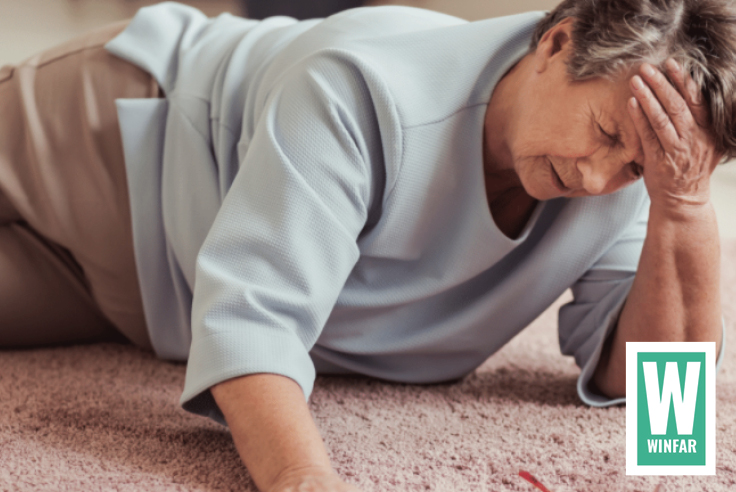Every year millions of seniors experience accidental falls that require medical attention and hospitalizations. As the aging process continues, a fear of falling can eventually limit an at-home senior’s activities to the point it threatens their wellbeing and independence. To help ensure that doesn’t happen to your loved one, preparation is key.
Helping a senior conquer their fears
First, have an open and honest discussion with them about falling, and their fear of falling. Then, offer your support to help alleviate those concerns. Once they’ve accepted your offer, work through the list of risk factors together [ Read article: Risk factors that contribute to a fall ]
Eliminate fall hazards
Go around the home together and remove trip hazards like slippery throw rugs or random pieces of furniture. Make sure all the items they use routinely are within easy arm’s reach. That their passageways and stairs are well-lit, and obstruction-free. Fall-proof their bathroom by adding grab bars, a shower transfer bench, or anti-skid strips.
Prepare for the worst
Then, plan for the worst-case scenario. There are some simple safety techniques you can learn for how to get up from a fall. Knowing what to do if you were to fall – and practicing ahead of time, is very empowering. Giving the confidence needed to help themselves out of the situation, and minimise injuries.
We highly recommend you discuss these tough topics in advance. That pre-planned and agreed steps are already in place, ensuring your older parent is equipped, knows what to do, who, and how to call for help.
Also, make sure every room has the necessary essentials. That there is an accessible landline, not just a call. A sturdy chair and blanket in reach of the floor. To provide added security for your loved one, consider purchasing a wearable fall alert device. That way, if they fall when no one is around, they can quickly alert first responders by simply pushing a button.
How to safely get up from a fall
This helpful 5 minute video demonstrates some basic safe techniques for getting up after a fall and outlines the key steps you can take to get up or to call for help.
Safety warning:
- Seniors should only consider getting up if they’re not injured or dizzy from the fall.
- If you feel you have insufficient strength to get up on your own, stay where you are for a moment, a sudden fall can be startling and upsetting. So take a moment to just relax. And stay as calm as possible. This will help you get over the shock of falling.
- Reassure yourself. Remember: you can’t fall any further. It’s not going to get worse. All you need to do now, is assess your situation and then slowly, take the necessary steps. Always assess injuries your condition first before moving
- Important: Seniors with serious health conditions or limited mobility should always consult their doctor or physical therapist for advice on what to do in case of a fall in order to prevent further injury.
How to get up from a fall when there are no injuries
1. Stay calm and still. Don’t move for a few minutes. Stabilise your breathing.
2. Figure out if you’re injured.
– Slowly move your hands and feet.
– Then move your legs out to the side.
– Move your arms, up above your head. If there is pain with any of those movements,
stay where you are, grab a nearby blanket – and call for help.
– If there is no pain, try and take a deep breath and check for any rib fractures.
– Lastly, check your head.
3. If there are no injuries, slowly roll onto your side, starting the movement with your head.
– Look in the direction that is most comfortable to move.
– If it’s most comfortable to look right, then look right and bend the opposite (left) knee up so your foot is flat on the ground.
– Next, move your right arm straight out to the side (so if you raised your left leg, straighten your right arm)
– Now, extend your left arm, and reach that arm across your body, rolling your body, as you move your arm over onto your side. Take a moment to rest.
4. Scrunch your knees up towards your belly, and slowly push up over into a crawling or seated position. Whichever you find easiest.
5. Don’t get up, stay on the floor. Shuffle or crawl slowly on your hands and knees toward a sturdy chair or piece of furniture. Don’t rush and rest as needed.
6. When you reach the chair, place yourself lengthwise across the front of the chair, so that you can rest against it, if necessary.
7. As best you can, try and tuck your feet underneath you. Put one hand on the floor, the other hand on the chair, one at a time. Supporting yourself with the chair, push up into kneeling.
8. From the kneeling position, bring your strongest leg up to a 90-degree angle by putting that foot flat on the ground. The other leg stays in kneeling position.
9. Place one hand on the chair, the other hand on your knee, and slowly swing your body into the chair Sit and catch your breath for a few minutes before doing anything else.
How to call for help when there are injuries
1. Stay calm and rest for a few moments. Figure out what parts of your body are injured.
2. If you have one, use an emergency medical alert device or mobile phone to call 911 or a family member for help. Tell them about your injuries.
3. If there’s a pillow nearby, put it under your head. If there’s a blanket or some clothing nearby, use it to keep yourself warm while you wait for help.(It’s important to try and keep these objects in each room in the house, just in case, including your bathroom and kitchen)
4. If you don’t have a medical alert device or a phone nearby, start yelling for help.
If you can’t yell, grab something nearby and use it to bang on the floor or on nearby furniture to make noise and attract attention. If you have made the necessary preparations for this situation, follow those steps. Again, we highly recommend you discuss these types of situations with your doctor, family, neighbors or caregivers in advance. Should you find yourself in such a situation, you have already agreed on what to do, to best grab their attention. And that help is at hand and everybody is informed and prepared.
DOWNLOAD our step-by-step guide for HOW TO SAFELY GET UP FROM A FALL HERE
DISCLAIMER: This website does not provide medical advice. This information, including text, graphics, images, and other material contained on this website is for information purposes only. No material on this site is intended to be a substitute for professional medical advice, diagnosis, or treatment. Always seek the advice of your physician or other qualified health care provider with any questions you may have regarding a medical condition or treatment before undertaking a new health regime, and never disregard professional medical advice or delay in seeking it because of something you have read on this website.
Sources:
Prevent Falls
CDC Falls
Fall Prevention
Falls Prevention at Home
Fall Prevention Exercises
Tips on Fall Prevention
Falls Prevention

